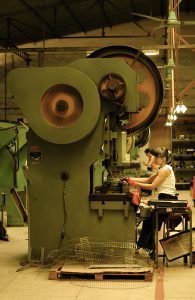
Manufacturers use a wide range of machines to manipulate and work raw materials into finished processes, one of which is a punch press. If a particular type of raw material is too hard to manually cut, a manufacturer may use a punch press. This large, heavy-duty machine is able to easily cut through hard materials, including metal, leaving behind holes in the same shape as the punch press’s die.
What Is a Punch Press?
As shown in the image to the left, a punch press is a large machine featuring a hydraulic-powered ram at the top. It typically features a workstation in front where a single worker can operate the ram. When the worker engages the ram, the workpiece is compressed against a fixed, stationary die. This creates a hole in the workpiece, as well as a new item out of the workpiece, which features the same shape as the die.
Punch presses are particularly useful for mass-producing small items with a uniform shape out of raw material. Even if a worker can manually punch holes through workpieces, a faster and more efficient solution is to use a punch press.
Punch Press Die Sets
Punch presses rely heavily on die sets to perform their intended punching operations. In a die set, there are both male and female dies. One of these dies is placed above the workpiece, whereas the other die is placed underneath the workpiece. The hydraulic-powered raw creates a hole in the workpiece by driving the punch through the die.
CNC-Controlled Punch Presses
While some manufacturers use manually operated punch presses, many use computer numerical controlled (CNC) punch presses. CNC-controlled punch presses use the same hydraulic ram to punch pre-shaped holes into workpieces. The difference, however, is that CNC-controlled punch presses are semi-automated using a computer.
As with other CNC-controlled machines, CNC-controlled punch presses allow manufacturers to streamline their production operations. Rather than manually operating a punch press, manufacturers can program it to run automatically. CNC-controlled punch presses still require some human intervention, but they are able to automate many tasks that would otherwise require a human worker.
Mechanical Punch Presses
In addition to hydraulic punch presses, there are also mechanical punch presses. Specifically, there are two types of mechanical punch presses: full revolution and part revolution. Full revolution punch presses live up to their namesake by requiring a complete cycle of the crankshaft, whereas part revolution punch presses only require a partial cycle of the crankshaft.
